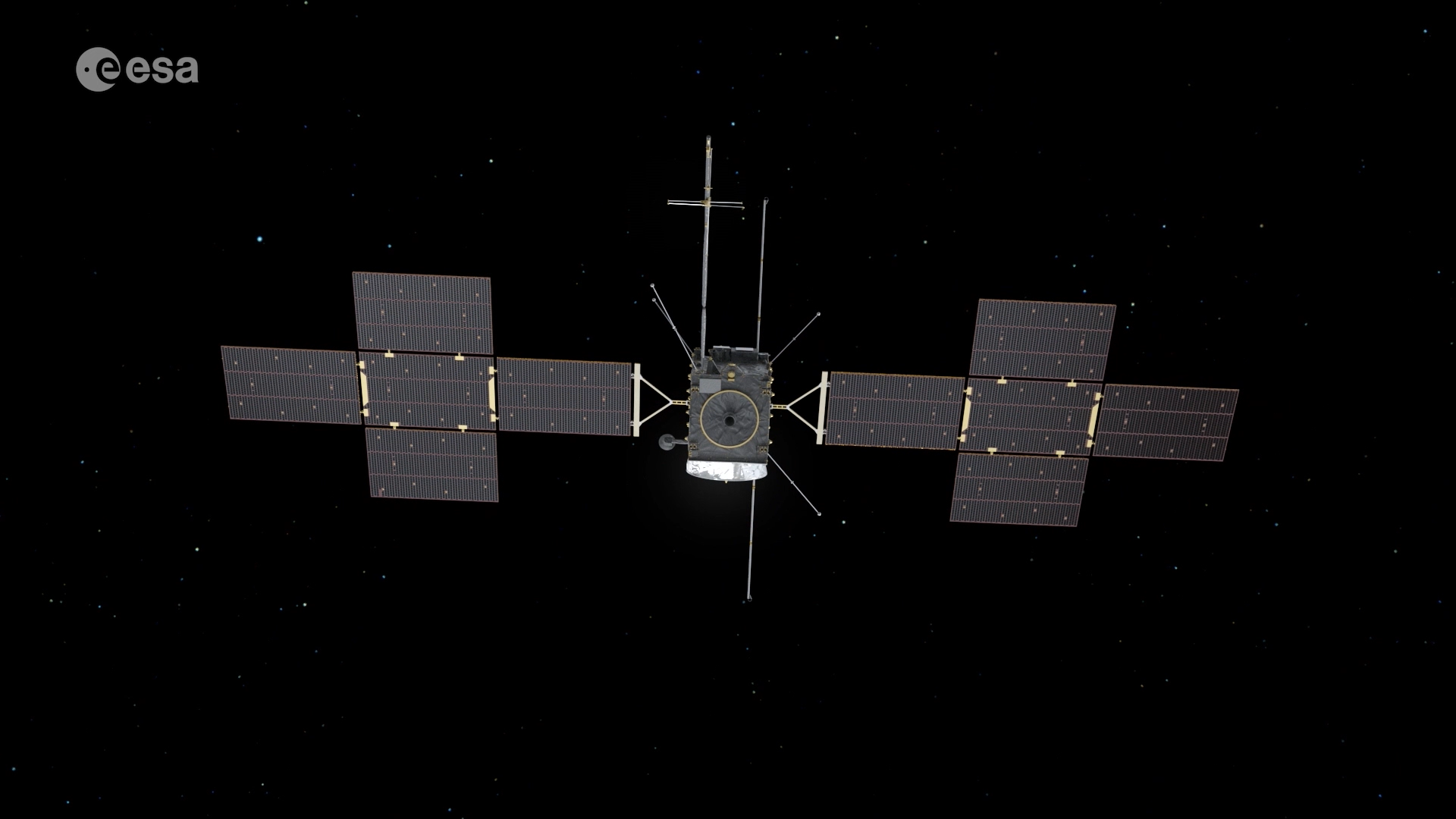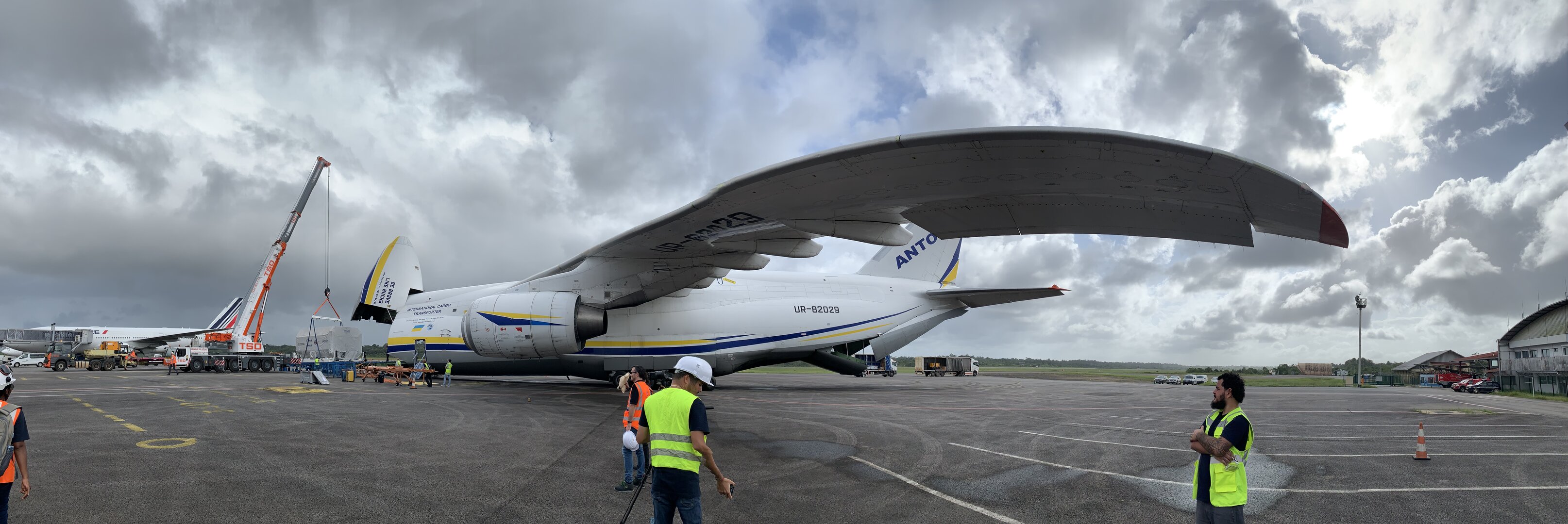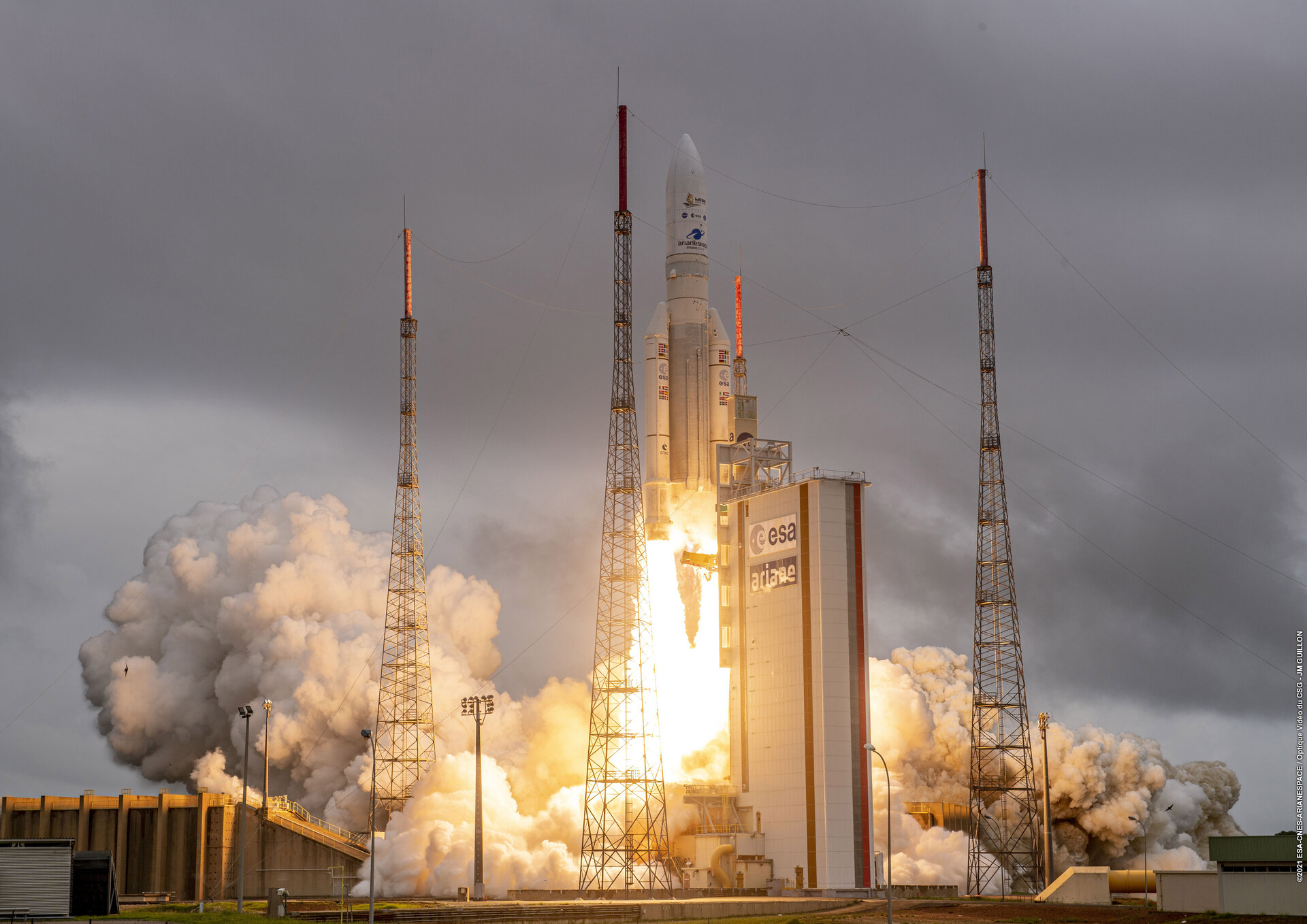11.02.2023
Juice on final stretch for launch to Jupiter

ESA’s mission to explore Jupiter and its largest moons has safely arrived at Europe’s Spaceport in French Guiana, where final preparations for its April launch are now underway.
The Jupiter Icy Moons Explorer – better known as Juice – arrived on 8 February at Félix Eboué airport in Cayenne by a special Antonov Airlines An-124 cargo flight from Toulouse, France, where prime contractor Airbus completed a nearly decade-long process of concept, design, testing and construction. Now, the spacecraft will undergo final testing and inspection by engineers from ESA and Airbus before it is fueled up and mounted on its Ariane 5 rocket.
Launch around mid-April will open an eight-year voyage to Jupiter. Packing a suite of 10 instruments, Juice’s mission is to study Jupiter’s large, ocean-bearing icy moons. The objectives include learning how such worlds might harbour life and studying the Jupiter system as a model for complex environments around gas giant planets across the Universe.
Jupiter is more than five times farther from the Sun than is our Earth, so getting there is a major challenge. After launch, a series of gravity-assist flybys of Earth and Venus will give Juice the speed and direction it needs to fly beyond the asteroid belt and reach the largest planet in our Solar System.
Following its arrival at Jupiter in 2031, Juice will be guided through another 35 flybys of the gas giant’s moons to explore its principal objectives: Callisto, Europa and Ganymede. The mission will conclude with an extended study of Ganymede – in 2034 it will become the first spacecraft to orbit a moon other than Earth’s.
To fly such a complex path over an enormous distance – and, crucially, to get Juice’s data home – will be an extreme test of navigation techniques. Mission controllers at ESA’s European Space Operations Control Centre (ESOC) in Darmstadt, Germany will be reliant on the Estrack network of deep space antennas in Spain, Argentina and Australia.
Launch itself will bring to a close a long tradition of ESA science missions starting atop an Ariane 5 rocket, including Rosetta and BepiColombo. Most recently, Ariane 5 sent the James Webb space telescope to deep space (pictured below) for NASA, ESA and the Canadian Space Agency on Christmas Day 2021.
For the huge effort, though, the scientific promise is mesmerising. Scientists believe that Callisto, Europa and Ganymede hold vast quantities of water buried under their surfaces in volumes far greater than in Earth’s oceans. These planet-sized moons offer tantalising hints that conditions for life could exist beyond our home planet – perhaps on worlds orbiting giant planets instead of hot stars. Jupiter and its family of large moons represent an archetype for giant gas planet systems across the Universe, and as such are some of the most compelling destinations in our Solar System.
ESA and Juice ride the momentum of a long human fascination with the planet named for the God of Gods in the Roman pantheon. Large in the night sky, Jupiter was naturally a target for one of the first telescope-assisted stargazers, Galileo. His observations, from 1610, discovered Io, Europa, Callista and Ganymede, and showed them to move, relative to Jupiter, from night to night – suggesting the controversial notion that Earth was not the sole centre of motion in the Universe.
To mark this watershed moment in our understanding of the cosmos, Juice carries a plaque celebrating Galileo’s work.
Quelle: ESA
----
Update: 1.03.2023
.
#SocialSpace: Apply to join Juice launch at ESA mission control

In brief
Join us at ESA’s mission control in Germany for the launch of Juice, the Jupiter Icy Moons Explorer. Juice is set to launch on an Ariane 5 rocket from Europe’s Spaceport in Kourou, French Guiana, on 13 April 2023. We are inviting passionate social media communicators to share the excitement as teams in Germany assume control of the mission, wake it up after the rigours of launch and kick start Juice’s long and complicated journey.
In-depth
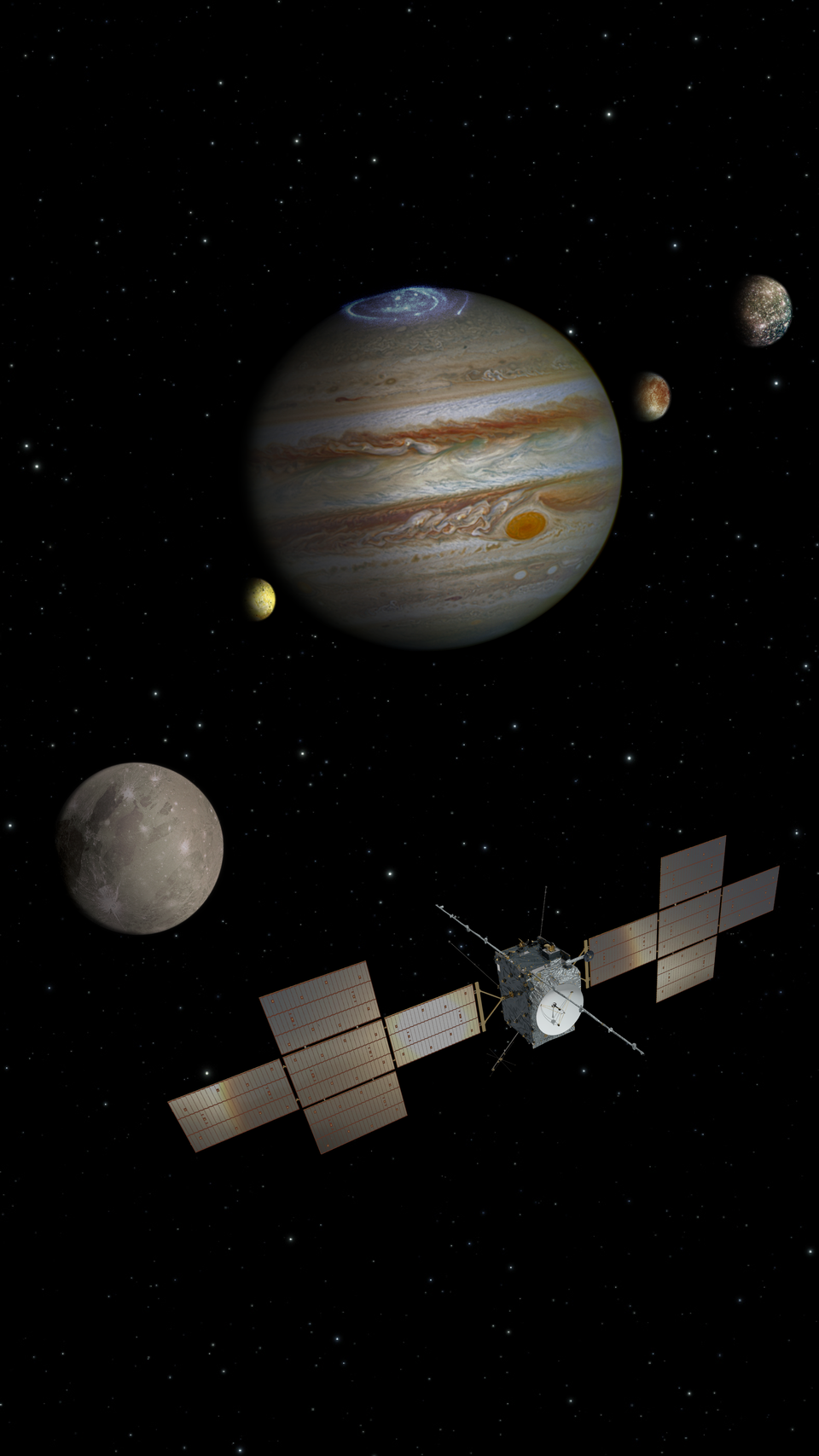
The two-day #SocialSpace event will take place over 12-13 April, in collaboration with Germany’s largest science centre, ‘experimenta’.
We are inviting 30 social media enthusiasts to ESOC mission control in Darmstadt for a behind-the-scenes view of the launch, with all the nerves and excitement that come with it. There will be a tour of the centre, special briefings, presentations and the chance to speak with the Flight Director and other mission experts.
The day before, we’ll visit experimenta in Heilbronn for an action-packed programme of science talks, tours, a trip to the Science Dome and an evening of observations at the experimenta observatory.
** Applications will open very soon! Keep an eye on @esaoperations on Twitter and save the dates! **
Why Jupiter?
Galileo's discovery of moons orbiting Jupiter 400 years ago lead to the reality-shifting realisation that Earth was not the centre of the Solar System. Probes have visited the system, and as is often the case in science, more questions were raised than answered. What will the Jovian moons reveal, or make us question, next?

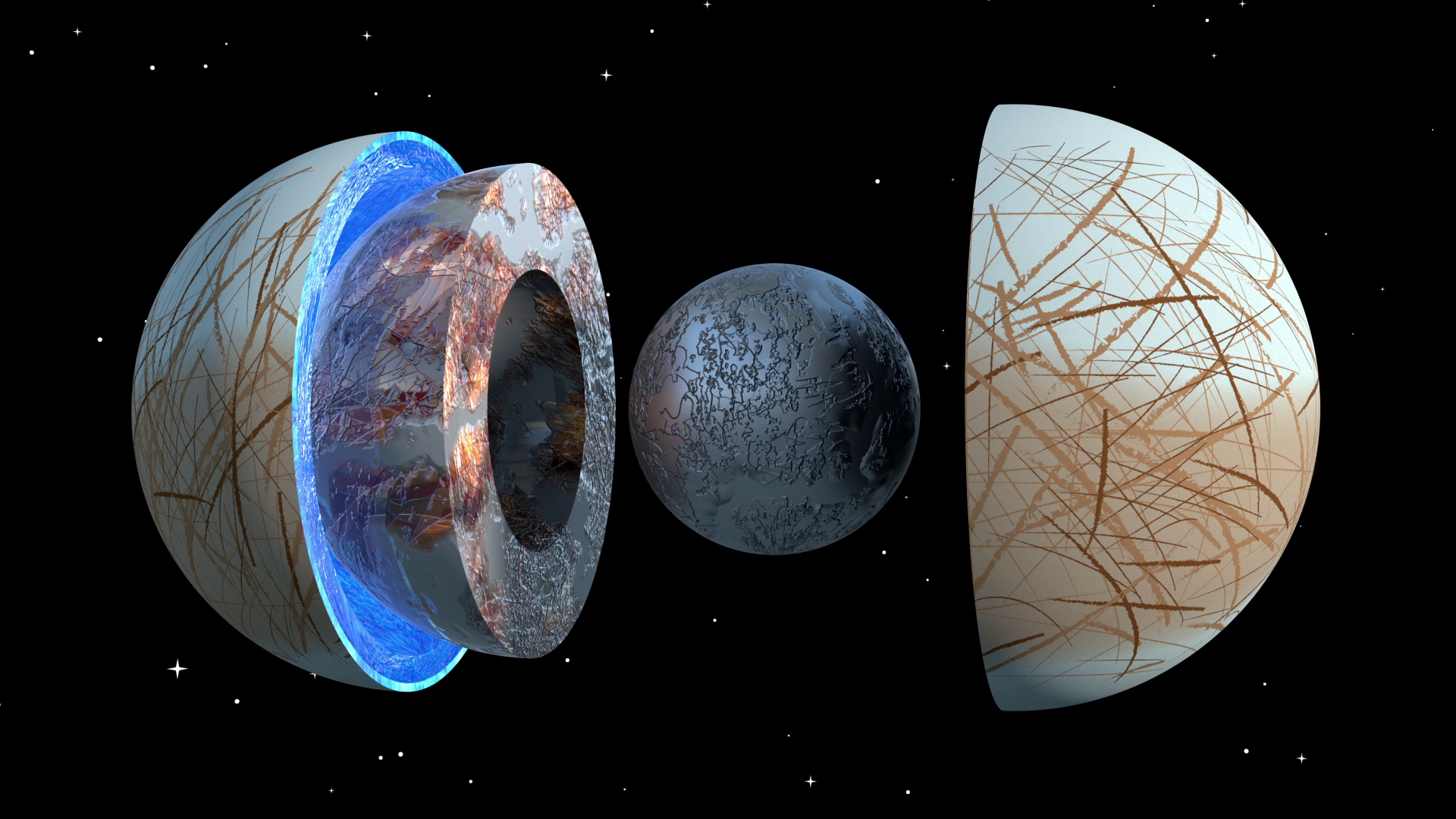
Access the video
Juice will make detailed observations of gas giant Jupiter and its ocean-bearing moons, characterising them with a powerful suite of remote sensing, geophysical and in situ instruments to discover more about these compelling destinations as potential habitats for past or present life.
#ESAJuice is an ESA mission with contributions from NASA, JAXA and the Israel Space Agency. It is the first Large-class mission in ESA’s Cosmic Vision programme.
Mission control: flying Juice on a journey of firsts

It will take eight years and three planetary flybys for Juice to get into orbit around the gas giant. Once there, it will perform 35 flybys of its largest icy moons, Europa, Ganymede and Callisto, before changing orbits to Ganymede, the largest and most massive of the three. Juice will be the first spacecraft ever to change orbits from another planet to one of its moons.
Over the course of the mission, teams at ESA's mission control centre will perform operations they never have before. It will be an exciting ride!
Join us for the #ESAJuice #SocialSpace!
Ever wondered how worlds form with the right conditions for life to thrive? Or how gas giants interplay with their planet-sized moons? Want to feel the nerves and excitement of a launch from where Europe’s missions are flown? Are you a passionate communicator who uses social media to engage the world?
This is just for you.
Apply to join us if you:
- Actively use one or more social networking platforms and tools to communicate to your audience.
- Regularly produce new content with multimedia elements.
- Have the potential to reach a large number of people using digital platforms.
- Reach a unique/diverse audience, distinctive from traditional news media or ESA audiences.
- Have an established history of sharing quality content, with previous posts that are visible and trustworthy.
- Follow one or more of ESA’s social media channels.
Programme
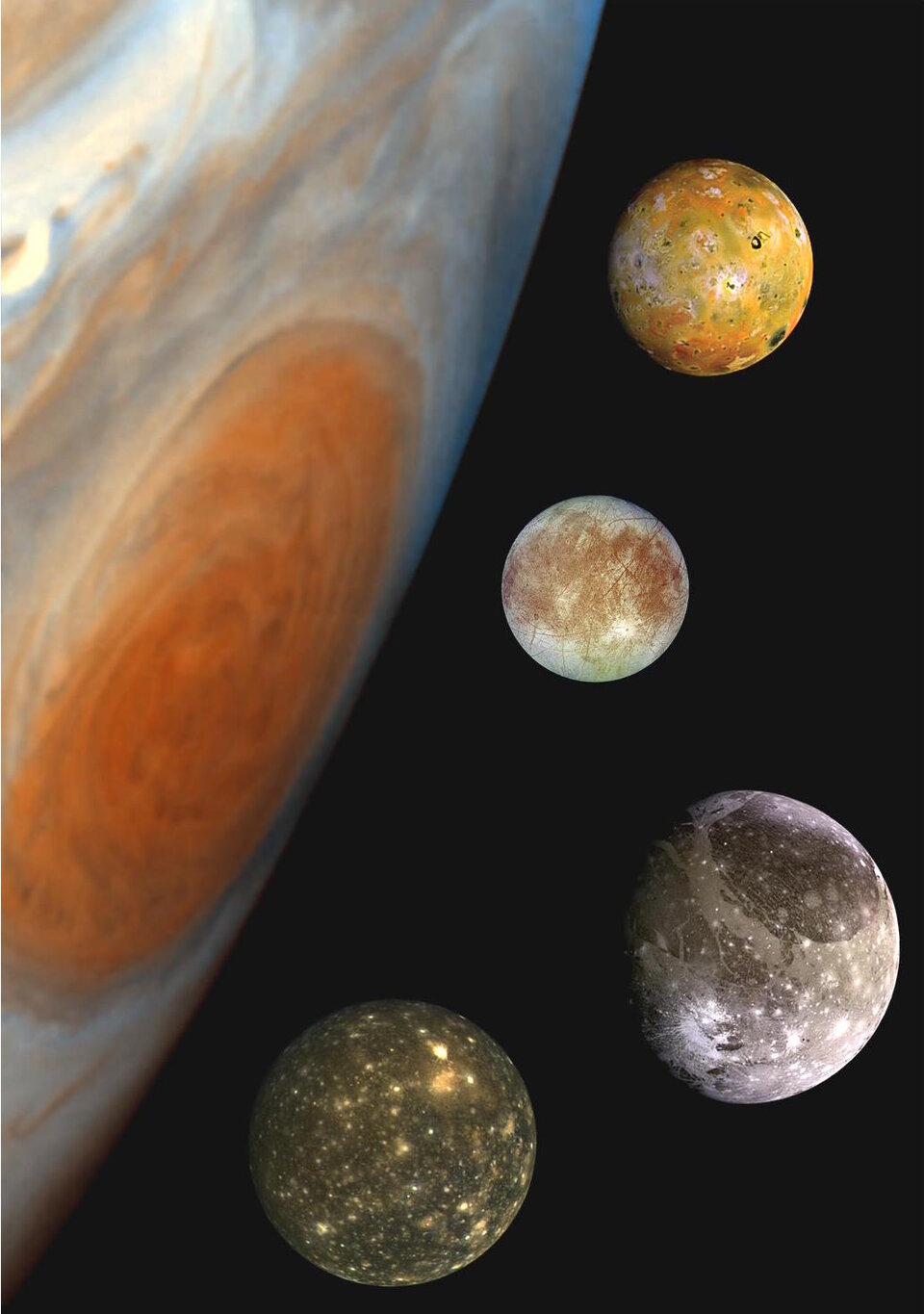
12 April: Day one will take place at ‘experimenta’ in Heilbronn, Germany. Attendees will join talks from a diverse mix of scientists, go on a personal tour of Germany’s largest science centre and a trip to the experimenta science dome, all capped off with an evening sky-watching at the centre’s observatory.
13 April: Launch Day! Next, join us at Mission Control for lift-off. Be there as ESA engineers take control of Juice at it separates from its rocket and kick-starts its bold journey. Enjoy a behind-the-scenes guided tour of ESOC facilities, meet the Flight Director and other mission experts, attend the on-site media briefing and learn about the mission, its path and what we hope to discover at Jupiter and its icy moons. Oh, and enjoy the winning #SpaceJuice!
**All launches are subject to unexpected delays. We will do our best to ensure the two-day programme continues in spite of any delays, but depending on the circumstances the nature and availability of the programme cannot be guaranteed.**
Dates, times and venue
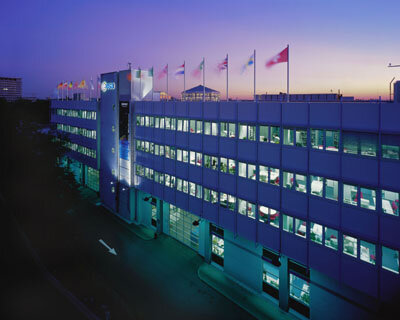
The #SocialSpace will be held over 12-13 April.
Applications will open soon. All applications must be submitted no later than midnight (CET) on Sunday, 12 March.
An invitation email with confirmation information and additional instructions will be sent to the selected participants on 15 March, and to those on the waiting list no later than 20 March.
Applicants will be responsible for their own costs including travel arrangements and accommodation. Light food will be available in the day on both days as well as transport between experimenta in Heilbronn and ESOC in Darmstadt.
Applicants must be at least 18 years old on 12 April 2023.
Quelle: ESA
----
Update: 14.03.2023
.
From vision to mission

The European Space Agency’s Juice space mission is scheduled to start its journey to Jupiter on April 13, 2023, where it will, among other things, search for traces of life on three of Jupiter’s icy moons. The University of Bern is strongly involved in this project. “uniaktuell” introduces some of the local researchers who are working hard on accomplishing the Juice mission.
By Brigit Bucher
The excitement is high: the Juice (JUpiter ICy moons Explorer) spacecraft is scheduled to begin its journey to Jupiter aboard an ARIANE 5 rocket from Europe’s Spaceport in Kourou, French Guiana on Thursday, April 13, 2023 at 2:15 p.m. After an almost eight-year journey, Juice will arrive at Jupiter to explore the largest planet in our solar system and three of its more than 80 moons. These are the icy dark worlds Ganymede, Callisto and Europa, ocean worlds where the average surface temperature is below minus 140 degrees Celsius. Ten instruments are on board Juice. The University of Bern is contributing the NIM mass spectrometer (which is part of the Particle Environment Package PEP) to the mission and is involved in two other instruments: the SWI Sub-millimeter Wave Instrument and the GALA Laser Altimeter.
A lot of time usually passes between the idea for a space mission and its implementation. At the University of Bern, there are some people who have been involved with Juice from the very beginning. One of them is Yann Alibert, now co-director of the local Center for Space and Habitability. For him, the University of Bern’s prominent involvement in Juice is a logical consequence of its long tradition and proven expertise in space research: “The University of Bern was already involved in the first moon landing with the solar wind composition experiment. Since then, we have been regularly participating in space missions by the major space organizations, such as ESA, NASA and JAXA,” says Alibert.
As a young postdoc, Alibert was involved in a proposal to ESA for a space mission to explore the Jupiter system. ESA had issued a call for mission proposals for its Cosmic Vision 2015-2025 space mission program in March 2007. At the time, Alibert was working on theoretical models of the formation of moons as well as Jupiter and Saturn. “Back then, we named our proposed mission after the French scientist Pierre-Simon Laplace. He was one of the first to suggest that planetary systems could form in a disk around the sun,” Alibert recounts. The LAPLACE proposal was selected by ESA and initially developed into the mission concept called EJSM (Europa-Jupiter System Mission) in collaboration with NASA. Building on this, the LAPLACE proposal was eventually refined by ESA into the Juice space mission. “So, in a way, Juice is the grandchild of LAPLACE,” Alibert explains, laughing. “The fact that our ‘idea’ is now flying to Jupiter makes me very proud, of course!”
Audrey Vorburger is the deputy co-principal investigator of the Particle Environment Package (PEP) and the lead scientist for one of PEP’s six instruments, the NIM mass spectrometer. NIM will one day study the chemical and isotopic composition and distribution of particles in the atmospheres of Jupiter’s icy moons as well as the physical parameters of the moons’ atmospheres. “Back in December 2009, I attended the very first PEP meeting as a member of the PEP team. We were then delighted to see ESA announce in May 2012 that Juice had been selected for implementation, and in February 2013 that PEP had been selected for the journey to Jupiter,” says Vorburger.
At the time when the respective Juice instrument teams were able to designate science co-investigators, Vorburger was analyzing the newly acquired data from the energetic neutral particle instrument CENA on board Chandrayaan-1 (India’s first mission to the moon) and working extensively on planetary atmospheres. “Since this gave me the perfect qualifications, I was appointed as one of the two science co-investigators for the NIM mass spectrometer,” she recalls.
For Vorburger, Juice is a dream come true: “It is a unique feeling to know that the instrument you are holding in your hand will one day fly into space and provide us with new insights into our universe.” Asked about her personal highlights during the project, she replies: “They are still to come: I am of course looking forward to the imminent launch of JUICE and the moment when we know that Juice is now safely on its way to the Jupiter system; and then of course to the first scientific data that our instruments will provide us with.” With regard to space research at the University of Bern, Vorburger says, “Entire missions are created at the University of Bern, from the vision, conceptualization and construction, to data analysis. And science and technology always go hand in hand. Science is being lived here!”
André Galli has been on the Juice team for a good ten years, pretty much since the moment ESA selected the Juice mission and confirmed that the University of Bern would be involved in the space mission to Jupiter. Galli is the project scientist for the NIM mass spectrometer. He explains, “I am involved in planning NIM’s measurements. I am conducting research in the lab and in theory for this so we have an idea of what to expect in terms of measurements in the future.”
When Galli joined the Juice team, he was a member of Professor Peter Wurz’s research team and had already been involved in space missions to Mars, Venus and in missions conducting solar wind research. For Galli, too, taking part in space missions was a long-held wish: “Ever since I was a teenager observing the planets and stars from a hill in the Emmental, I’ve been dying to be involved in a space mission.”
Because of the scale and complexity of space missions like Juice, international collaboration is essential: the budget required usually far exceeds what any single country (except perhaps the U.S.) can provide for such a complex mission, and the necessary expertise usually cannot be found in any single country either. Working in such large international teams over decades is exciting, but also demanding, as Galli explains: “It also requires frustration tolerance and perseverance from everyone involved. As a long-distance runner, I have just the right prerequisites for this.”
Someone who joined the Juice team later is the current NIM project manager Andreas Riedo. “I had just returned from my Einstein fellowship in Berlin in 2020. The project manager at the time, Davide Lasi, took a job in the U.S., and that’s when Professor Peter Wurz approached me and asked if I would be interested in joining Juice during this exciting phase.” Riedo had repeatedly been involved in space missions since his master’s degree: “But with the Juice job offer, I was immediately catapulted to the front line of space missions. Which was just perfect!”
He also talks about the highly complex international collaboration: “At the University of Bern, we were responsible for the integration and testing of three other Juice instruments, known as the PEP-Lo NU system, with contributions from Germany, Finland, Sweden, Hungary. All the work is thus extremely international, and all the cogs have to run in sync with each other for us to be able to deliver good work.” This is very complex, but makes the work exceptionally exciting.
“High-tech instruments for space research have been developed and built at the University of Bern for decades,” Riedo raves: “Which is why we built a unique technical environment to put such instruments through their paces.” For example, vibration tables to simulate rocket launches. Or large chambers that allow testing of how the developed systems work in space conditions.
The Juice mission aims to answer fundamental questions about the formation of planets and their moons – and it also involves the search for signs of life. Data from earlier space missions and model calculations suggest that there are subsurface oceans far below Ganymede’s and Europa’s external ice layers. Based on today’s knowledge, the oceans have all the properties that are needed for life to be created – and to exist in the long term. Riedo says: “The impact on humans and our way of thinking, if we find signs of life? Indescribable! For the first time ever, we could say that we are not alone.”
Quelle: University of Bern
----
Update: 15.03.2023
.
JUICE arrives in French Guiana for launch, project manager outlines next steps

Set for launch from the Centre Spatial Guyanais (CSG) in Kourou, French Guiana, on April 13, 2023, the European Space Agency’s (ESA’s) Jupiter Icy Moons Explorer (JUICE) mission will aim to uncover the secrets of Jupiter’s three largest icy moons: Ganymede, Callisto, and Europa. JUICE’s suite of instruments will allow scientists to thoroughly explore and characterize the moons, each of which is thought to feature large bodies of liquid water beneath their surfaces — creating potentially habitable environments for life.
Following the completion of construction and testing at an Airbus facility in Toulouse, France, JUICE was shipped to the CSG in French Guiana, where it arrived on Feb. 9, 2023, and is currently being processed for its launch in April.
Many milestones and goals lie ahead for the JUICE teams — both before and after launch. NASASpaceflight conducted a one-on-one interview with Cyril Cavel, JUICE program manager at Airbus Defence and Space in Toulouse, France, for more information on the mission and how launch processing is progressing in French Guiana.
JUICE’s History
JUICE began as a re-formatted version of ESA’s Jupiter Ganymede Orbiter mission, which was a component of the canceled NASA/ESA Europa Jupiter System Mission – Laplace (EJSM-Laplace) proposal. Following the announcement of JUICE’s mission proposal, it became a candidate for the L-class mission of ESA’s Cosmic Vision program, which aims to select and launch solar system exploration and astronomy spacecraft.
JUICE was selected as the first L-class mission (L1) of Cosmic Vision on May 2, 2012. Spacecraft payload selection took place in Feb. 2013, and Airbus Defence and Space was selected as JUICE’s prime contractor in July 2015. As prime contractor, Airbus would be responsible for designing, constructing, and testing JUICE, all of which was done at Airbus’ facility in Toulouse, France.

Render of the JUICE spacecraft. (Credit: ESA)
In March 2016, the Mission and System Requirements Review was completed, allowing Airbus to begin the design and construction phase of the mission. Meanwhile, 2017 saw the spacecraft and instrument preliminary design reviews, as well as the Ground Segment Requirements Review, the latter of which was completed the following year in Dec. 2018.
The design phase of JUICE’s mission ramped up significantly in 2019, with the Spacecraft Critical Design Review completed in March and the Science Ground Segment Design Review completed the following month. In Sept. 2019, the assembly of JUICE’s flight model began, officially kicking off the construction phase of the mission.
Impacts from the COVID-19 pandemic then significantly delayed the spacecraft’s construction, with final integration and testing only beginning in mid-2022. Meanwhile, the Ground Segment Readiness Review was only completed in November, and JUICE’s Qualification and Acceptance Review was finally finished on Jan. 18, 2023 — bringing the construction and testing phases of the mission to a close.
JUICE’s Launch Processing
After arriving at the CSG, the spacecraft was moved to the Payload Preparation Facility and unpacked, allowing launch processing procedures to begin.
“We’re also doing a lot of tests, leakage tests, electrical checkouts, and performance tests in order to verify that after transportation and at the very end of all spacecraft environmental test campaigns in France, the Chemical Propulsion Subsystem is still working fine,” said Cavel.
These types of post-shipment re-verification checks are common with various satellites.
“In parallel to that, we are doing a number of final functional tests on the spacecraft — so exercising all the functional chains of the platform and the instruments in order to verify that we are good to go,” added Cavel. “We’ll be doing this [until about mid-March].”
As part of his position as JUICE’s project manager, Cavel oversaw the construction, testing, and shipment of JUICE. He is currently stationed in French Guiana, where he is closely monitoring JUICE’s launch processing procedures and, eventually, the launch itself.
One such procedure Cavel will oversee in French Guiana is the transfer of JUICE from one processing facility to another. Once teams finish preparing JUICE in the Payload Preparation Facility, the spacecraft will need to be moved to the Hazardous Processing Facility.
“Around mid-March, we will move to another facility here at CSG called the Hazardous Processing Facility or HPF. This is the facility where we will fuel the spacecraft. We have to load three and a half tons of fuel inside our big propellant tanks, which are inside the central cylinder of the spacecraft.”
“This is performed by our subcontractor, ArianeGroup. It’s a hazardous activity that will take approximately two weeks,” said Cavel.

Once all of the needed propellants are loaded into JUICE, the spacecraft will then be moved to the Ariane 5 rocket’s processing facility, where it will be mated to the launcher’s upper stage.
“And then we will proceed to the mating of the spacecraft to the launcher interface adapter. This is the start of what we call ‘combined operations.’ We will meet the launcher and process [the two vehicles] in parallel. So final preparation of the spacecraft and launcher occurs then, including mating, fairing encapsulation, and the very final activities before the final launch countdown.”
When launch day arrives, currently slated for April 13, 2023, JUICE will be lofted into space atop an Ariane 5 rocket from pad ELA-3, in what will be the penultimate launch of an Ariane 5. After separating from the top of the Ariane 5 upper stage, the spacecraft will begin an eight-year journey to the Jovian system.
During JUICE’s coast phase, the spacecraft will perform a total of four flybys — one of the Earth-Moon system in Aug. 2024, one of Venus in Aug. 2025, and then two more of Earth in Sept. 2026 and Jan. 2029. Each of these flybys will see JUICE utilize the gravity of either Earth-Moon, Venus, or Earth to increase its velocity without the use of propellants.
At the completion of the fourth and final flyby, JUICE’s aphelion (the farthest point from the Sun in its orbit) will reach Jupiter’s orbital plane. These maneuvers are called gravity assists and serve to increase a spacecraft’s velocity and, thus, alter its overall orbit.
Assuming an on-time launch and successful completion of all four gravity assists, JUICE will arrive at Jupiter in July 2031, performing its first flyby of an icy moon, Ganymede, shortly after entering Jupiter’s sphere of influence.
Over the next three years, JUICE will perform multiple flybys of Ganymede, Callisto, and Europa, ultimately culminating with the spacecraft entering orbit around Ganymede in December 2034, where it will live out the remainder of its mission.
JUICE will eventually use all of its propellants to deorbit itself from Ganymede in late 2035, impacting the surface of the moon shortly after.
(Lead image: JUICE is unpacked following its delivery to the CSG in French Guiana. Credit: ESA-CNES-Arianespace/Optique video du CSG/S. Martin)
Quelle: NS
----
Update: 31.03.2023
.
Sabotaging Juice
In-depth
Sat in a windowless office beneath ESA’s Main Control Room in Darmstadt, Germany, Petr and Filipe have complete control over the Juice spacecraft and ESA’s deep space ground stations across the globe – and they take full advantage.
These aren’t the real 35-metre antennas or the actual spacecraft (currently in Kourou, French Guiana), but a complex simulator. For teams that will really fly Juice, it all looks, feels and behaves just like the real thing. The ‘problem’ for them is, it keeps going wrong.
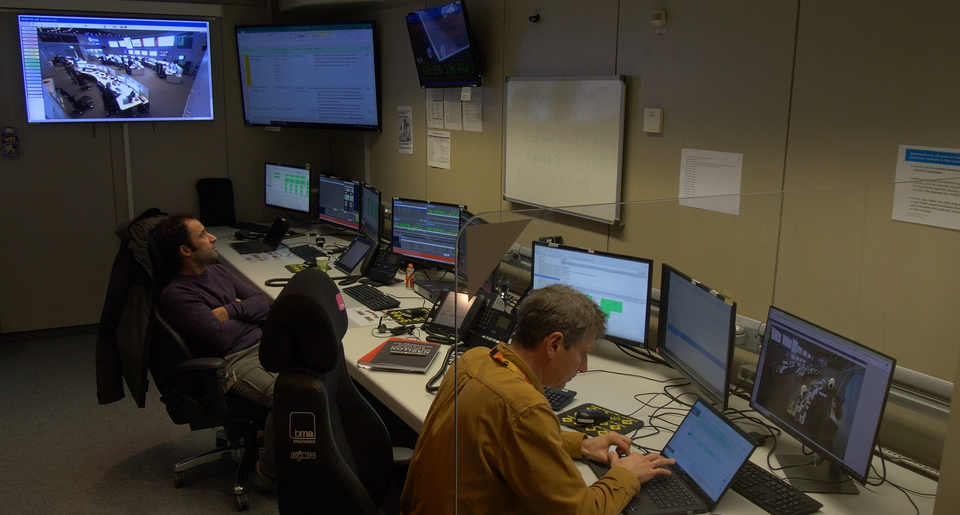
Simulations take place here at the European Space Operations Centre in the months before any mission flies. They vary, testing different elements of various teams’ abilities; from the functioning of the spacecraft to external threats like solar radiation and debris, and more human issues like team cohesion, confidence or sickness. Simulations are designed to make sure any problem that happens in space can be confidently resolved on the ground.
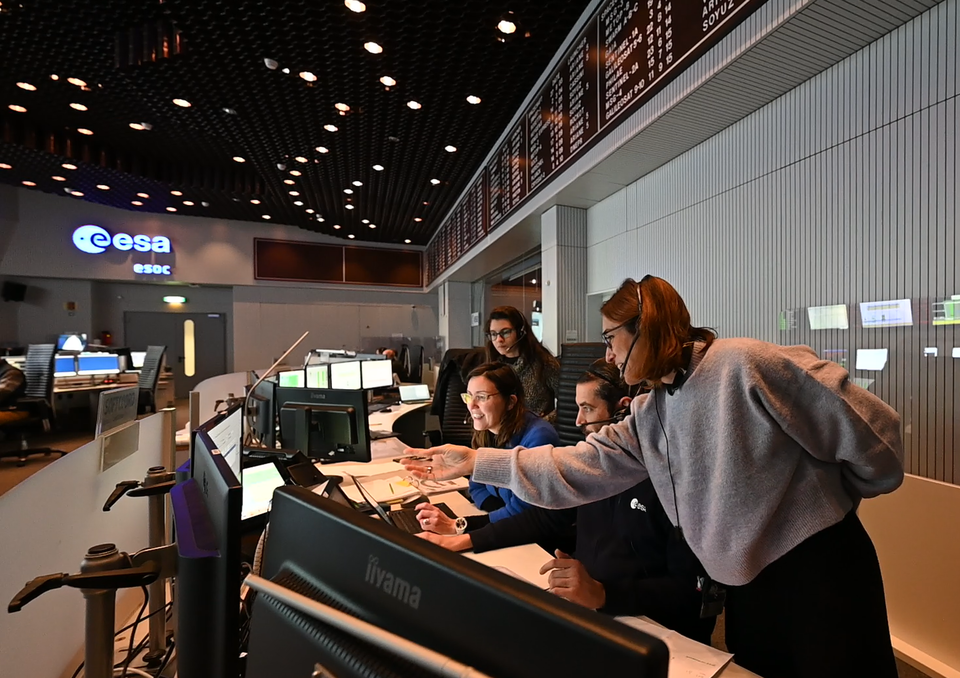
In the current simulation, the Juice Red Team is ‘on console’. This is the team that will be on deck for 12 hours seeing the mission through lift-off and separation from its Ariane 5 rocket, and as it wakes up from the rigors of launch.
It’s not long to go before Ignacio must hand over to his counterpart, Angela, Spacecraft Operations Manager for the Blue Team, after which he and his team have another 12 hours to rest before they return to the Main Control Room. The handover is coming up, but the Red Team hasn’t yet gotten to the bottom of multiple failures on the spacecraft.
“We unite the team against us”


Access the video
Down in the 'simulations bunker', the Simulations Officers are revelling in their dastardly plan as it comes into fruition. All around them are screens showing the scenes above. They can see the concerned teams, hear their conversations and they even watch what they are doing on each of their console screens.
“It looks like we have a failure due to operator error,” says Deputy Flight Operations Director Bruno Sousa, his voice playing out from the Control Room above.
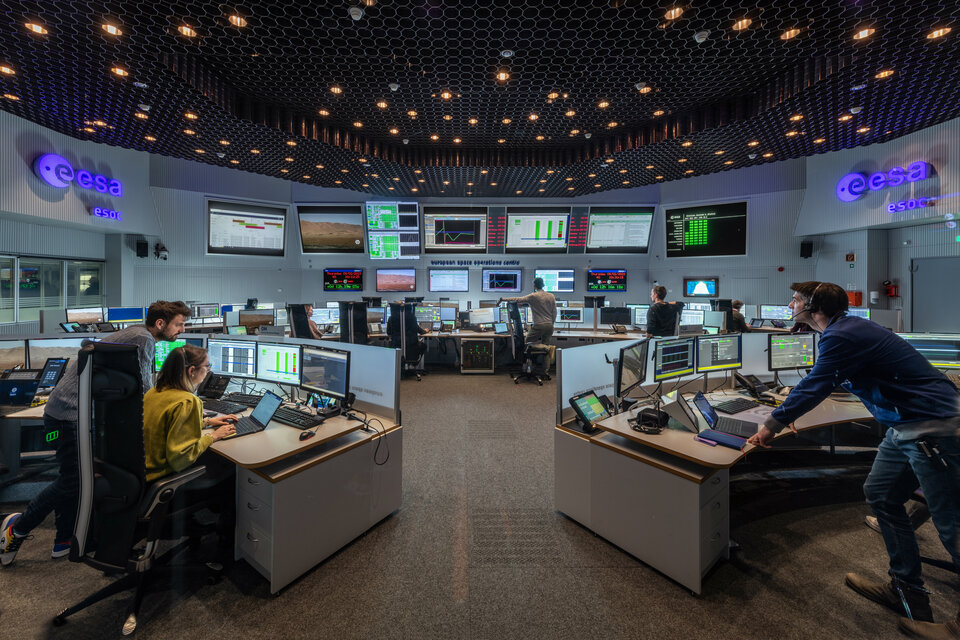
“Ha, no,” says Prime Sim Officer Petr Shlyaev. “I can see why they would think that, but they didn’t do anything wrong here. They are blaming themselves without any reason!.”
Juice has already gone into Safe Mode twice – a protective state when instruments turn off and the spacecraft runs just its most basic functions – alerting the control teams to a problem.
Recovering a spacecraft from this mode is exhausting; they must get to the root of the problem, reboot the central computer and power-off several units, all with low visibility on the state of the spacecraft. It takes a lot of work to get back to nominal operations.

As the team tries to get to the root of Juice's issues, the Simulations Officers below continue commanding the simulator, listening in on their responses and watching how they handle these complex, unideal scenarios.
“One of our primary goals is to unite the team, and one of the several ways we do it is by uniting them against us,” says Filipe Metelo, Deputy Sim Officer for Juice.
“For this simulation, we really wanted to test the two teams’ ability to handle errors as they arise just before a handover, to test how they communicate what has happened to the next team who will be taking over a mission in distress.”
“If they don’t do this properly, they – and Juice – will be punished.”
The handover
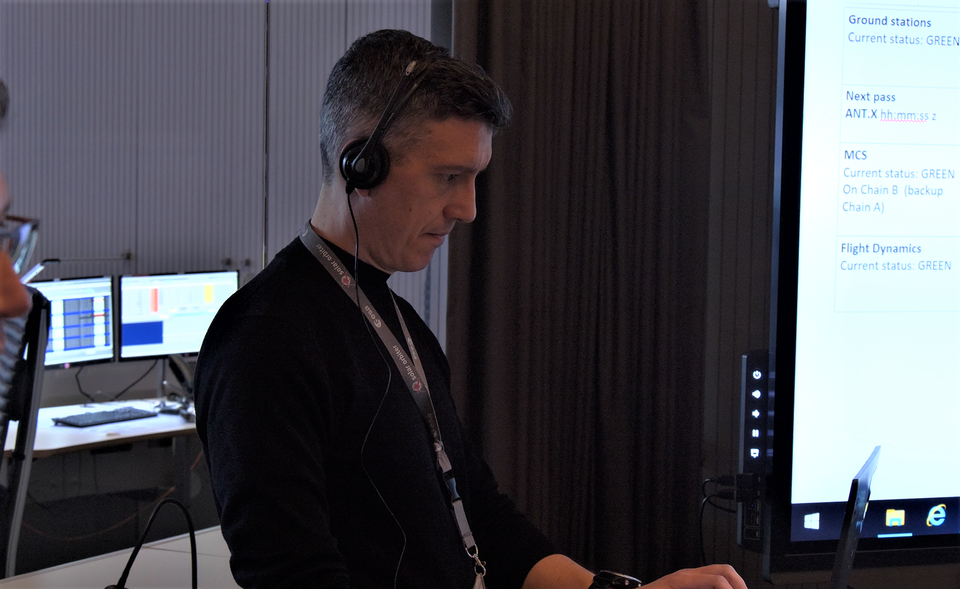
Looking a little tired, standing in front of the new team eager to hear from him, Ignacio admits, “I’m sorry to say, we are leaving you with a mess. It’s the worst I’ve seen: we have multiple undiagnosed failures that you guys need to deal with.”
Angela Dietz, managing the next team, asks, “Is Juice in Safe Mode?”
"Not quite", explains Ignacio, “It’s in Red State: something has failed but we haven’t even touched it - we don’t have a full grasp of the situation. Something is ongoing, not diagnosed, not contained, not solved. Sorry”
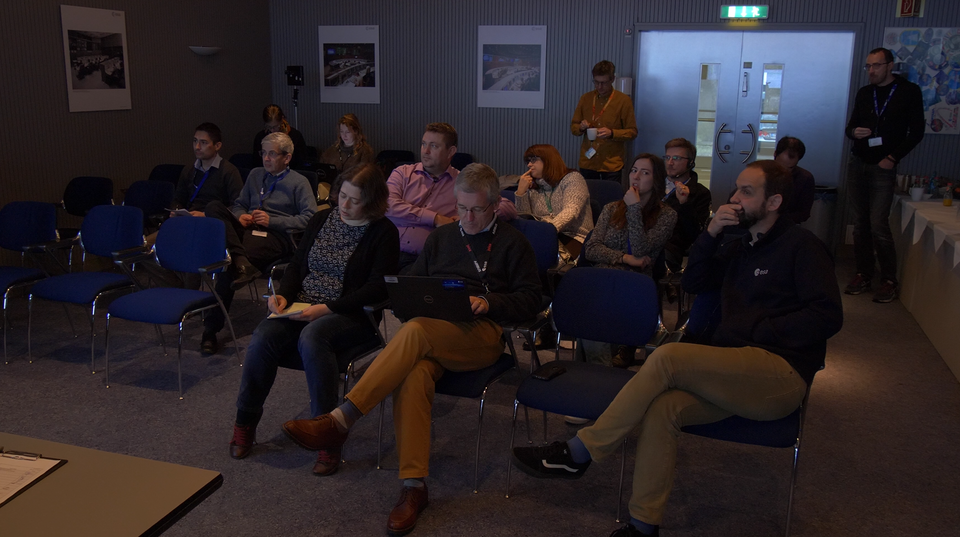
Despite the mess they found themselves in, by the end of the next shift the teams had got Juice back on track and onto its regular timeline (not before they had to deal with yet another Safe Mode!).
In the early stages of a mission’s life, the ‘Launch and Early Orbit Phase,’ teams are on hand 24 hours a day to welcome a mission to its new home and get it on the right path. Admittedly, the series of events created in this scenario is unlikely to happen all at once in real life – but it is possible.
For months, engineers have been flying a fake spacecraft that keeps going wrong. In just a couple of weeks, they fly the real thing. What they are doing now, helps ensure this bold mission’s success.
The real thing
Juice is humankind’s next mission to the outer Solar System, launching on 13 April from Europe's Spaceport in Kourou, French Guiana. Its journey to Jupiter and its icy moons, Ganymede, Callisto and Europa, will be one like no other we’ve flown before.

With four Planetary flybys to get to the gas giant and 35 flybys of its icy moons, teams at ESA’s Operations Centre will be performing back-to-back critical operations with a mission that’s more massive than any we’ve flown to deep space.
This ambitious mission will characterise these moons with a powerful suite of remote sensing, geophysical and in situ instruments to discover more about these compelling destinations as potential habitats for past or present life.
Juice will monitor Jupiter’s complex magnetic, radiation and plasma environment in depth and its interplay with the moons, studying the Jupiter system as an archetype for gas giant systems across the Universe.
Quelle: ESA

